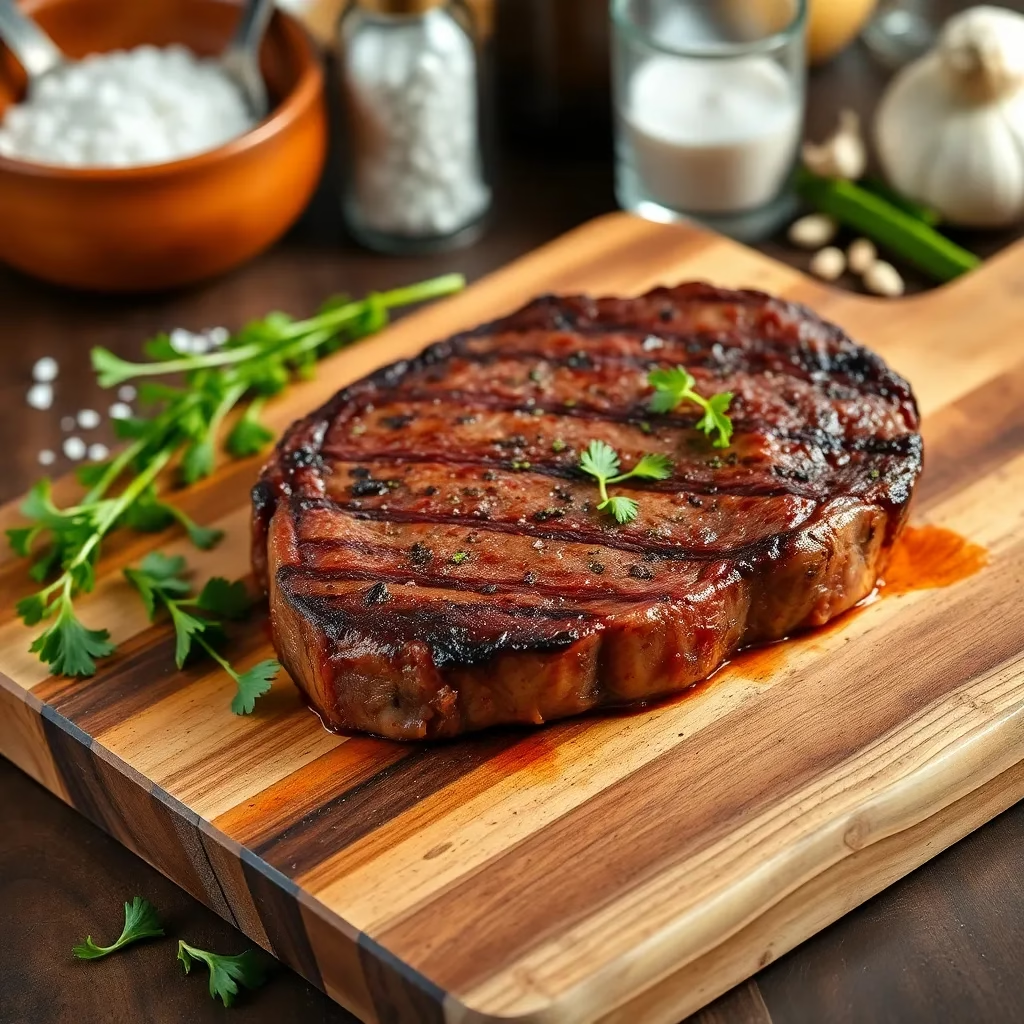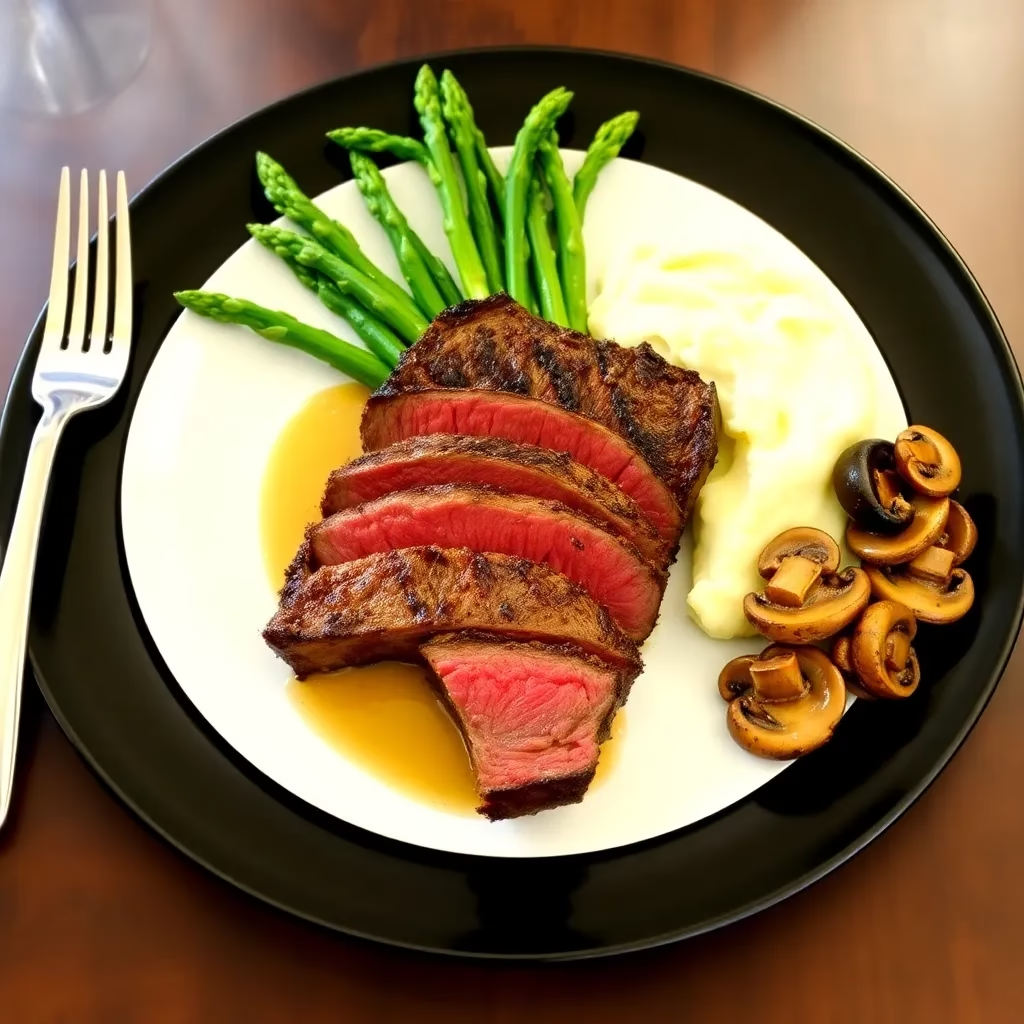Table of Contents
Ribeye Steak Recipe(Intro)
Ribeye steak recipe is well known for being bold in flavour, full of rich marbling and being so tender. Regardless of how seasoned a cook you are, this easy ribeye recipe will show you, step-by-step how to get the perfect juicy ribeye, each and every time. Here you’ll learn how to make your ribeye better than any steakhouse with expert techniques and simple ingredients meant to harness flavor.

Ingredients Needed for Ribeye Steak Recipe
- Ribeye Steaks (1 to 1.5 inches thick): When buying ribeye, pick cuts with a decent amount of the marbling (visible streaks of fat within the meat). Ribeye is famous for its flavor and juiciness. This fat is what makes it, so to speak. While the ribeye will benefit from some of the additional flavor that bone in will provide, a bone less version works beautifully as well.
- Salt (Sea Salt or Kosher Salt): The natural flavors of the steak aren’t overwhelmed, and these both do a wonderful job of adding flavor without overpowering the steak.
- Freshly Ground Black Pepper: A sportier and aromatic grinding of fresh is preferred.
- Cooking Oil with a High Smoke Point: These work well because they don’t burn at high temperatures: avocado oil, vegetable oil or grapeseed oil.
- Butter (Unsalted): Perfect when basting, adds a touch of richness.
- Optional Aromatics: Increasing your steak’s flavor profile can be achieved by including fresh rosemary, thyme, and garlic cloves.
Preparation Tips
Bringing Steak to Room Temperature
The ribeye steak needs to be room temperature before you begin cooking. A steak left at room temperature for 30 to 45 minutes guarantees equal cooking throughout, therefore producing a more constant texture and taste.
Patting Dry
Pat the steak as dry as paper towels will allow to achieve a beautiful crust. Moisture is the enemy of a nice sear, as too much water hamstrings you from developing that nice crispy, golden brown crust on the steak’s exterior.
Seasoning Generously
Still, seasoning is a crucial first step toward truly highlighting the natural taste of your steak. On both sides of the meat, lay plenty of salt and freshly ground black pepper. It adds to flavor, it helps it get a crust when you sear it. If you enjoy adding spices to your egg and pumpkin stew, feel free to substitute in garlic powder and onion powder or smoked paprika.
- Pro Tip: Use a marinade or dry rub, then leave it to stand for at least 30 minutes, but simple seasoning sometimes lets the natural flavor do all the work.
Cooking Method: Maximum Juiciness Pan Searing
Ribeye (or any other steak) can be pan seared to a beautiful crust while maintaining a wonderful juiciness in the center.

Step 1: Preheat the Skillet
Preheat a skillet or heavy bottom pan over medium heat. It is cast iron that we prefer since it retains and distributes heat evenly – important for a perfect sear. Don’t add any ingredients to a hot skillet that is almost smoking.
Step 2: Add Cooking Oil
When the skillet gets hot add a little cooking oil. Select an oil with a high smoke point, like avocado oil, vegetable oil, grapeseed oil. Allow the oil to shimmer before adding it. This gives you a quick sear that locks in juices.
Step 3: Sear the Ribeye
Put the ribeye steak in the hot skillet, carefully. Once it comes into contact do not move it. It’s important to build a crust in this step. Turn the steak and sear for 3-4 minutes on the first side without it touching. When it lets go of the pan on its own and has a golden brown crust you’ll know it’s ready to flip.
Step 4: Flip and Continue Cooking
Sear for another 3-4 minutes using tongs, flip the steak to the other side. The final internal temperature will be at about 130-135°F and perfect for medium rare. To ensure accuracy, use a meat thermometer:
- Rare: 120-125°F
- Medium-rare: 130-135°F
- Medium: 140-145°F
- Medium-well: 150-155°F
- Well-done: 160°F and above
Whether it’s your stove’s heat or the thickness of your steak, you may want to cook times vary.
Step 5: Add Butter and Aromatics (Optional)
Add a few tablespoons of butter to the skillet, reduce the heat slightly. As the butter melts, add aromatics such as thyme, crushed garlic cloves, rosemary sprigs. Turn over the scalp; add two tablespoons of butter and the aromatics; tilt the skillet and baste the steak with the melted butter and aromatics. One more layer of flavor and richness are added by this step.
Step 6: Rest the Steak
Slip the steak to a plate and loosely cover with aluminum foil. Let it sit for a few minutes 5 or 10. Without resting, you end up with juices that are sitting on top of the steak because the cut of meat isn’t wide enough to allow for proper redistributing of the juices.
Alternative Cooking Methods
While pan-searing is our preferred method, you can also explore these alternatives:
Grilling Method
- Light a grill or heat a charcoal grill to medium high heat.
- Season the ribeye as described above.
- Season steaks with salt and pepper on both sides; grill the steaks for 4 – 5 minutes per side, or until internal temperature is reached.
- Serve the steaks after 5-10 minutes resting.
Oven Finishing
- If you have thick cuts, use a stovetop to oven method. Ribeye: Sear for 2-3 minutes per side in a hot skillet, remove from heat, place in a preheated oven, 400 degrees.
- Put the steak to cook for another 5-7 minutes until your desired doneness of the steak.
- Rest as usual before serving.
Serving Suggestions
Then slice the ribeye steak against the grain to serve. In addition, it guarantees the very best tenderness with each bite. Pair your ribeye with classic sides like:
- Garlic mashed potatoes
- Steamed asparagus
- Garlic and herbs sautéed mushrooms
- A fresh garden salad

You can add a little extra with a spoonful of compound butter or steak sauce.
Expert Tips for Perfect Ribeye Steak
- Control the Temperature: For searing you need high heat and be ready to lower the heat so you don’t burn the aromatics.
- Use a Meat Thermometer: A meat thermometer makes precise cooking of a certain doneness easy.
- Allow for Resting: That drop in temperature is what leads juices to escape and your steak to dry out if you skip the resting period.
- Butter Basting: Although it’s optional, basting with butter does improve taste and moisture.
Common Mistakes to Avoid
- Over-seasoning or Under-seasoning: It is mostly about striking the ideal balance. A bit too much salt can overwhelm; a little too little can make the steak taste flat.
- Crowding the Pan: Make sure you cook one steak at a time or have enough space in between several steaks. Steaming instead of searing depends on overcrowding.
- Skipping the Resting Period: Leaving a steak alone to rest will retain the juices, so you get more juice flavored steak.
- Overcooking: Nine times out of ten, if you overcook your food, a meat thermometer is your best friend.
Conclusion
Making a nice and juicy ribeye steak at home will surprise you since it is simpler than you would imagine. The good news is you can create restaurant quality steak right at home with some excellent ingredients, easy preparation, and just the proper procedures. If you would want to make this meal your own, feel free to experiment with seasonings, sides, and cooking techniques outside this presentation. So turn on your grill or skillet and savor every single luscious bit.
Ribeye Steak Recipe(FAQs)
What is the best recipe for ribeye steak?
Seasoning the steak completely with salt and pepper then pan sear it in a hot cast iron skillet with a little oil until it has a wonderful, crusty sear (about 3 to 4 minutes per side). Added at the last minute of cooking, butter, garlic and herbs baste the steak; resting it for five to ten minutes ensures it will remain juicy.
How to cook a ribeye steak recipe?
First season the ribeye by topping one side, just the pink parts, with a sprinkle of salt and some pepper, then leave it out on the counter for 30 minutes or so to warm up. Add oil to a skillet over medium high heat and sear steak 3 to 4 minutes on all sides or until it heats up to desired temp for medium rare (130 to 135°F). For optional basting during the final couple minutes of cooking, add butter, garlic, and herbs; let the steak rest 5 to 10 minutes before serving.
How to grill ribeye steak recipe?
Grilling ribeye steak is easy; turn your grill to medium high. After liberally seasoning steak with salt and pepper, grill it for medium rare, or until desired doneness, 4 to 5 minutes on each side. Let a grilled steak rest for five to ten minutes; thinner cuts call for a two zone heat approach: sear over high heat and finish on lower heat.
What is the best recipe for ribeye steak?
The ideal recipe for a ribeye steak calls for pan-sear cooking: Season it with salt and pepper; sear it in a hot skillet with oil for the crusty outside; then, butter basting, garlic, and herbs will complete it. Let the steak rest for five to ten minutes for optimum juiciness and taste.

